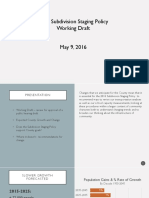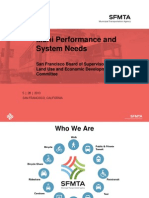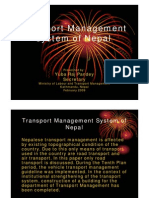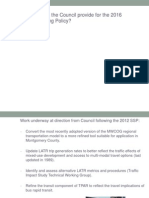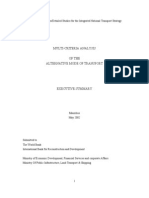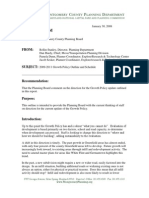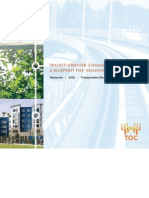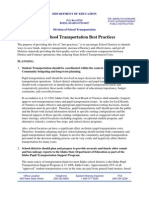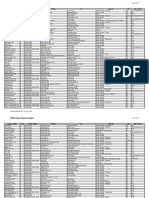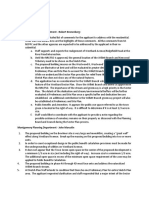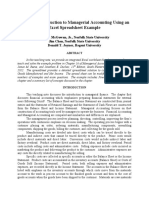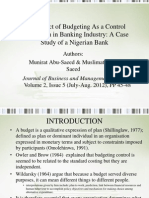Subdivision Staging Policy: Overview Presentation October 19, 2015
Subdivision Staging Policy: Overview Presentation October 19, 2015
Uploaded by
Planning DocsCopyright:
Available Formats
Subdivision Staging Policy: Overview Presentation October 19, 2015
Subdivision Staging Policy: Overview Presentation October 19, 2015
Uploaded by
Planning DocsOriginal Title
Copyright
Available Formats
Share this document
Did you find this document useful?
Is this content inappropriate?
Copyright:
Available Formats
Subdivision Staging Policy: Overview Presentation October 19, 2015
Subdivision Staging Policy: Overview Presentation October 19, 2015
Uploaded by
Planning DocsCopyright:
Available Formats
SUBDIVISION STAGING POLICY
Overview Presentation
October 19, 2015
Intro
Todays Topics:
Overview of the Subdivision Staging Policy (SSP)
Transportation
Schools
Infrastructure funding
Schedule and Public Participation
2003-2005
Intro
Several initiatives currently underway:
Forum on Growth & Infrastructure held on March 7, 2015.
Council-directed transportation research.
Cross-agency work group on school design options.
Collaboration with MCPS on student generation rates.
Intro
What have we been hearing?
How can we better forecast what might happen in the future?
How can we best address school crowding and traffic
congestion?
How can we fund our infrastructure needs most cost-effectively?
How can new development help to pay for or provide
improvements?
Overview
Subdivision Staging Policy (aka Growth Policy until 2010) is
Adopted every 4 years by the County Council. Policy includes
criteria and guidance for the administration of the Adequate Public
Facility Ordinance (APFO).
The purpose of the APFO is to coordinate the timing of
development with the provision of public facilities such as roads,
transit and schools.
The next Subdivision Staging Policy will be adopted in 2016.
Overview
We mainly test the adequacy of the transportation network (roads and
transit) and schools.
Current tools used to measure transportation adequacy:
Transportation Policy Area Review (TPAR)
Local Area Transportation Review (LATR)
Current tool to measure school adequacy:
Annual School Test
Transportation
Transportation Policy Area Review is a policy area test of adequacy.
2. Aspen Hill
3. Bethesda CBD*
4. Bethesda/Chevy Chase
5. Clarksburg
6. Cloverly
7. Damascus
8. Derwood
9. Fairland/White Oak
10. Friendship Heights
11. Gaithersburg City
12. Germantown East
13. Germantown Town Center
14. Germantown West
15.Glenmont*
16. Grosvenor*
17. Kensington/Wheaton
18. Montgomery Village
19. North Bethesda
20. North Potomac
21. Olney
22. Potomac
23. R&D Village
24. Rockville City
25. Rockville Town Center*
26. Rural East
27. Rural West
28. Shady Grove*
29. Silver Spring CBD*
30. Silver Spring/Takoma
31. Twinbrook*
32. Wheaton*
33. White Flint*
34. White Oak
*Metro Station Policy Area
Transportation
Under Transportation Policy Area Review:
Roadway Adequacy
Policy area average arterial roadway congestion
cannot exceed specified standard.
Standard varies depending on transit availability and
usage.
Transit Adequacy
Focuses on the availability and quality of local
transit service.
Three metrics considered: coverage, peak
headway, span of service.
Transportation
Roadway Adequacy:
2014 TPAR Roadway Adequacy Test
Rural
Suburban
Urban
Relative to the 2012 TPAR test:
White Oak (WO) & Fairland/Colesville (FC) are reported as
separate policy areas
For most policy areas, results are generally similar Countywide
Three additional policy areas deemed inadequate North Potomac
(NP), Aspen Hill (AH) & Bethesda Chevy Chase (BCC)
9
Transportation
Transit Adequacy:
Transit Adequacy Standards
Minimum Coverage
Maximum Headway
Minimum Span
Urban
80 percent
14 minutes
17 hours
Suburban
70 percent
20 minutes
14 hours
Rural
>50 percent
<60 minutes
>4 hours
Coverage- How much of a policy area is within walking distance of transit?
Peak Headway How frequently do buses arrive?
Span of Service How many hours a day is transit service available?
If a policy area does not achieve adequacy for all three measures, that
policy area is determined to be inadequate for transit.
10
Transportation
Transportation Mitigation Payment
If projected transportation capacity in a policy area is
inadequate, the Planning Board may approve a
subdivision in that area if the applicant commits to either:
Fully mitigate the incremental traffic impact of the
subdivision by adding capacity or implementing a
trip reduction program; or
Pay a Transportation Mitigation Payment as
provided in County law.
11
Transportation
Local Area Transportation Review
Tests capacity of nearby intersections.
Applied to all projects generating 30 or more peak hour trips.
If an intersection fails, developer can make improvements,
mitigate trips or in limited cases make a payment to the
County.
12
Transportation
Direction from Council following the 2012 SSP:
Convert the most recently adopted version of the MWCOG regional
transportation model to a more refined tool suitable for application in
Montgomery County.
Update LATR trip generation rates to better reflect the traffic effects of
mixed-use development and access to multi-modal travel options (last
updated in 1989).
Identify and assess alternative LATR metrics and procedures (Traffic
Impact Study Technical Working Group).
Refine the transit component of TPAR to reflect the travel implications of
bus rapid transit.
13
New Ideas
Expand the pro-rata share concept beyond White Oak
Look at incorporating Vehicle Miles of Travel (VMT) metric into
the LATR process
Consider consolidation of LATR and TPAR into a single
transportation test
14
Schools
Annual School Test
School adequacy is measured for each school level by high
school cluster.
15
Schools
Annual School Test
School facility adequacy is based on projected school capacity
compared to projected enrollment.
16
Schools
Annual School Test
Projected capacity measures existing and planned school capacity.
Existing school capacity is defined as MCPS program
capacity.
Planned school capacity is the capacity funded in the 6-year
CIP.
17
Schools
Annual School Test
Projected enrollment is based on several factors:
Births in the County.
Aging of the school-age population.
Migration of residents into and out of the County.
Housing (new housing and the resale of existing homes).
Forecast 5 years into the future.
18
Schools
Annual School Test
Test is conducted annually at all three school levels (elementary,
middle and high) for a school cluster area.
When projected enrollment exceeds projected capacity (termed
utilization level), either a payment is required for development to
proceed or a moratorium is imposed.
19
Schools
Annual School Test
The threshold for moratorium is 120 percent utilization.
This means projected enrollment 5 years in the future exceeds 120
percent of projected capacity (existing and planned).
Exceptions:
Senior or Age-restricted Housing.
No more than 3 new housing units, School Facility
Payment still required.
20
Schools
Annual School Test
Threshold for requirement to make a School Facility Payment (SFP) is
105 percent utilization.
This means projected enrollment 5 years in the future exceeds 105
percent of projected capacity but does not exceed 120 percent.
Payment is required for each school level over 105 percent.
Payment rates vary by school level based on construction costs and
dwelling unit type.
21
Schools
Annual School Test
Student Generation Rates - an estimate of the number of students
generated by different housing types.
New methodology developed in cooperation between Montgomery
County Public Schools (MCPS) and Montgomery County Planning.
Two major inputs:
Student addresses with grade-level information
attached (confidential information removed).
Parcel File with residential structure information.
22
New Ideas
Work with MCPS to update student generation rates and
develop measures of housing turnover.
Continue collaboration on school design. Cross-agency
Work Group on School Design Options report recently
released.
Continue joint community meetings such as the one held
Sept. 17th with the Walter Johnson Cluster.
23
Infrastructure Funding
Impact Tax, Facility/Mitigation Payment, Recordation Tax
Impact taxes are assessed on new residential and commercial
buildings, and additions to commercial buildings to help fund
improvements necessary to increase transportation or public
school capacity.
Some exemptions apply MPDUs, multi-family senior housing,
development in an Enterprise (or former Enterprise) zone.
School Facility Payments and Transportation Mitigation
Payments are levied on development located in an area with
inadequate facilities.
A recordation tax is an excise tax levied when a land transfer is
recorded in the Maryland Land Records such as the purchase of
new or existing home.
24
Infrastructure Funding
Transportation Impact Taxes - All new development is required to
pay a transportation impact tax levied on every dwelling unit
constructed, and on every new square foot of non-residential
development.
Building Type
Single-family detached (per unit)
Single-family attached (per unit)
Multi-family low-mid rise (per unit)
Multi-family high rise (per unit)
Multi-family senior (per unit)
Office (per sq ft of GFA)
Industrial (per sq ft of GFA)
Bioscience (per sq ft of GFA)
Retail (per sq ft of GFA)
Place of Worship (per sq ft of GFA)
Private School (per sq ft of GFA)
Hospital (per sq ft of GFA)
Social Service Agency (per sq ft of GFA)
Other non-residential (per sq ft of GFA)
Metro Station
Policy Area
$
$
$
$
$
$
$
$
$
$
$
$
$
$
Clarksburg
6,984
5,714
4,443
3,174
1,269
6.35
3.20
0
5.70
0.35
0.50
0
0
3.20
General
$ 20,948
$ 17,141
$ 13,330
$ 9,522
$ 3,808
$ 15.30
$
7.60
$
0
$
3.70
$
0.90
$
1.35
$
0
$
0
$
7.60
$ 13,966
$ 11,427
$ 8,886
$ 6,347
$ 2,539
$ 12.75
$
6.35
$
0
$ 11.40
$
0.65
$
1.05
$
0
$
0
$
6.35
25
Infrastructure Funding
School Impact Taxes - All new residential development is required
to pay a school impact tax levied on every dwelling unit constructed.
The school impact tax = approximately 90 percent of the cost of a
student seat.
School Impact Tax
Single-family detached
$26,827
Single-family attached
$20,198
Multi-family Low-Mid Rise
$12,765
Multi-family High Rise
$5,412
26
Infrastructure Funding
School Facility Payments and Transportation Mitigation
Payments are levied on development located in an area with
inadequate facilities.
Transportation Mitigation Payments = 25 percent of the
transportation impact tax for roadway or transit inadequacy.
In areas inadequate for both roadways and transit, payment
rates are set to equal 50 percent of the impact tax.
School Facility Payments = 60 percent of the cost of a
student seat.
Montgomery County School Facility Payment Rates
Elementary
Middle
High
Single-family detached
6,940
3,251
4,631
Single-family attached
4,160
1,743
2,754
Multi-family low to mid rise
2,838
1,169
1,877
Multi-family high rise
1,166
531
804
27
New Ideas
Infrastructure Financing
Update school and transportation impact tax rates based on
current construction/capital costs
Consider localized use of school and transportation impact
taxes (within the cluster or policy where collected)
Evaluate the proportion of costs covered by impact taxes
Consider changes in recordation tax collected
Consider options for public private partnerships
28
Schedule & Participation
Briefing on New TPAR Transit Adequacy Component
and Trip Generation Rate Update
December 2015
Briefing on Advanced Modeling Tool by consultant
January 2016
Work Sessions on Draft LATR/TPAR Recommendations
February and March 2016
Draft Status Report on General Land Use Conditions &
Forecasts
February 2016
Draft School Test and Impact Tax Recommendations
March 2016
Working (Staff) Draft
April/May 2016
Public Hearing on the Working (Staff) Draft
May 2016
Work Sessions on the Working (Staff) Draft
June 2016
Planning Board Draft and Resolution
July 2016
Council Public Hearing on the Planning Board Draft
September 2016
PHED Committee Work Sessions
September/October 2016
County Council Work Sessions
October/November 2016
Council Adoption
Required by November 2016
29
30
QUESTIONS?
You might also like
- Pressco, IncDocument6 pagesPressco, Incrasmitamisra0% (1)
- TIA Guide For The PhilippinesDocument12 pagesTIA Guide For The PhilippinesAnonymous koR9Vtf100% (5)
- IAB Transport Funding FINALDocument29 pagesIAB Transport Funding FINALBen RossNo ratings yet
- Terms Conditions BL LARA CMA CGM A4 ValideDocument1 pageTerms Conditions BL LARA CMA CGM A4 ValideDanish Azmi100% (1)
- EsrdthfyguhijkDocument27 pagesEsrdthfyguhijkAnuragBajpaiNo ratings yet
- MEMO FAX CVP Analysis SampleDocument26 pagesMEMO FAX CVP Analysis SampleLita LinvilleNo ratings yet
- Document A - Newark Anniversary Guide (Excerpt) - 1Document4 pagesDocument A - Newark Anniversary Guide (Excerpt) - 1Rafael DevonishNo ratings yet
- Appendix 3: Growing SmarterDocument23 pagesAppendix 3: Growing SmarterPlanning DocsNo ratings yet
- Subdivision Staging Transportation Recommendations Subdivision Staging Policy Community Meeting II April 12, 2016Document36 pagesSubdivision Staging Transportation Recommendations Subdivision Staging Policy Community Meeting II April 12, 2016Planning DocsNo ratings yet
- The 2016 Subdivision Staging Policy Public Hearing DraftDocument72 pagesThe 2016 Subdivision Staging Policy Public Hearing DraftPlanning DocsNo ratings yet
- Introduction To Montgomery County's Adequate Public Facilities Ordinance and Growth PolicyDocument4 pagesIntroduction To Montgomery County's Adequate Public Facilities Ordinance and Growth PolicyPlanning DocsNo ratings yet
- What Payments Are Required of New Development?Document13 pagesWhat Payments Are Required of New Development?Planning DocsNo ratings yet
- OC Transpo 2015 Budget PresentationDocument53 pagesOC Transpo 2015 Budget Presentationmpearson78No ratings yet
- The Colorado ExperienceDocument24 pagesThe Colorado ExperienceCristinaNo ratings yet
- Lessons From LOS Reform: Defining and Measuring SuccessDocument64 pagesLessons From LOS Reform: Defining and Measuring SuccessPlanning DocsNo ratings yet
- Memorandum: M C P DDocument4 pagesMemorandum: M C P DPlanning DocsNo ratings yet
- Center For Urban Transportation Research: College of Engineering University of South Florida TampaDocument40 pagesCenter For Urban Transportation Research: College of Engineering University of South Florida TampaPlanning DocsNo ratings yet
- Discussion On Assignment #1Document17 pagesDiscussion On Assignment #1Hari PNo ratings yet
- Draft Revenue Constrained Transportation Scenarios: Transportation and Regional Planning Committees - Aug. 1, 2014Document30 pagesDraft Revenue Constrained Transportation Scenarios: Transportation and Regional Planning Committees - Aug. 1, 2014api-63385278No ratings yet
- Montgomery County Subdivision Staging Policy Draft Peer ReviewDocument8 pagesMontgomery County Subdivision Staging Policy Draft Peer ReviewPlanning DocsNo ratings yet
- 2016 Subdivision Staging Policy Working Draft May 9, 2016Document27 pages2016 Subdivision Staging Policy Working Draft May 9, 2016Planning DocsNo ratings yet
- DPD Parking Review Report (April 13, 2015)Document11 pagesDPD Parking Review Report (April 13, 2015)heidigrooverNo ratings yet
- Section VI: Assessing The Effectiveness of Specific Provisions: Public SchoolsDocument4 pagesSection VI: Assessing The Effectiveness of Specific Provisions: Public SchoolsPlanning DocsNo ratings yet
- Smart Commute Evaluation: Tools, Techniques and Lessons Learned in Monitoring and Evaluating Workplace-Based TDM ProgramsDocument36 pagesSmart Commute Evaluation: Tools, Techniques and Lessons Learned in Monitoring and Evaluating Workplace-Based TDM ProgramsRatheesh Kumar NairNo ratings yet
- Managed Lanes Corridor Project Feasibility StudyDocument28 pagesManaged Lanes Corridor Project Feasibility StudyDistrict Department of TransportationNo ratings yet
- How Is Transportation Adequacy Determined?Document9 pagesHow Is Transportation Adequacy Determined?Planning DocsNo ratings yet
- Community Transit - Draft 2021 Transit Development PlanDocument72 pagesCommunity Transit - Draft 2021 Transit Development PlanThe UrbanistNo ratings yet
- 2012 Transportation Policy Area Review: A Synopsis of The Area-Wide Transportation TestDocument14 pages2012 Transportation Policy Area Review: A Synopsis of The Area-Wide Transportation TestPlanning DocsNo ratings yet
- Travel Demand Management - Measures, Behavioural Impact and User ResponseDocument21 pagesTravel Demand Management - Measures, Behavioural Impact and User ResponsePranav Mishra100% (1)
- ATUR Trafik TIA 2018Document72 pagesATUR Trafik TIA 2018JK Bersatu VetroNo ratings yet
- 2013-05-28 Muni Performance Productivity Impacts FINALDocument29 pages2013-05-28 Muni Performance Productivity Impacts FINALJoeEskenaziNo ratings yet
- East Ramapo Central School District: Intensive Review of TransportationDocument8 pagesEast Ramapo Central School District: Intensive Review of TransportationRyan ChatelainNo ratings yet
- Land Use: VisionDocument5 pagesLand Use: VisionPlanning DocsNo ratings yet
- Creating Mode Shift To Active Transportation CCNET April 2012Document31 pagesCreating Mode Shift To Active Transportation CCNET April 2012api-25976591No ratings yet
- Lone Star Rail Dec 2011Document21 pagesLone Star Rail Dec 2011oldtownersNo ratings yet
- Transport Management System of Nepal: Yuba Raj Pandey SecretaryDocument33 pagesTransport Management System of Nepal: Yuba Raj Pandey SecretaryShakya Enzo Murcielago CountachNo ratings yet
- What Direction Did The Council Provide For The 2016 Subdivision Staging Policy?Document7 pagesWhat Direction Did The Council Provide For The 2016 Subdivision Staging Policy?Planning DocsNo ratings yet
- PRMF Factsheet 6 Monitoring and Evaluation 2012 AprilDocument2 pagesPRMF Factsheet 6 Monitoring and Evaluation 2012 AprilPRMF Knowledge CentreNo ratings yet
- Multi-Criteria Analysis of The Alternative Mode of TransportDocument8 pagesMulti-Criteria Analysis of The Alternative Mode of TransportZaid FutlooNo ratings yet
- S47 - Regional Prioritization of Freight Networks - LTC2013Document28 pagesS47 - Regional Prioritization of Freight Networks - LTC2013walaywanNo ratings yet
- Memorandum: M C P DDocument16 pagesMemorandum: M C P DPlanning DocsNo ratings yet
- Strategic Research Direction Goals and Strategic FocusDocument4 pagesStrategic Research Direction Goals and Strategic FocusradenmasNo ratings yet
- National Urban Transport PolicyDocument18 pagesNational Urban Transport Policytinkerbell_91100% (1)
- Section II: Overview of The Annual Growth Policy: BackgroundDocument9 pagesSection II: Overview of The Annual Growth Policy: BackgroundPlanning DocsNo ratings yet
- Communication Skills ReportDocument8 pagesCommunication Skills ReportSaad ShahidNo ratings yet
- Transit-Oriented Communities: A Blueprint For Washington State, November 2009Document78 pagesTransit-Oriented Communities: A Blueprint For Washington State, November 2009Terry MaynardNo ratings yet
- Tpec 2022 02Document12 pagesTpec 2022 02MuzammilNo ratings yet
- Public Schools: Broward CountyDocument105 pagesPublic Schools: Broward CountyDanSweeneyNo ratings yet
- Montgomery County, MD: Jurisdictional ContextDocument63 pagesMontgomery County, MD: Jurisdictional ContextPlanning DocsNo ratings yet
- Roundtable With The Montgomery County Planning BoardDocument37 pagesRoundtable With The Montgomery County Planning BoardPlanning DocsNo ratings yet
- Penang Integrated Transport PlanDocument76 pagesPenang Integrated Transport PlanKent KMNo ratings yet
- Deenbandhu Chhotu Ram University of Science and TechnologyDocument9 pagesDeenbandhu Chhotu Ram University of Science and TechnologyAanchalNo ratings yet
- Transportation Infrastructure Projects: From Conception To ImplementationDocument49 pagesTransportation Infrastructure Projects: From Conception To ImplementationParth doshiNo ratings yet
- Idaho School Transportation Best Practices: PlanningDocument12 pagesIdaho School Transportation Best Practices: PlanningNess AnsonNo ratings yet
- VMT Taxation: A Modest Proposal: Alex Pazuchanics Katie Ross Randy Caruso Lauren PessoaDocument18 pagesVMT Taxation: A Modest Proposal: Alex Pazuchanics Katie Ross Randy Caruso Lauren PessoarcarusoNo ratings yet
- Toward Sustainable Growth For Montgomery County: A Growth Policy For The 21Document321 pagesToward Sustainable Growth For Montgomery County: A Growth Policy For The 21Planning DocsNo ratings yet
- SJ 5121 - Transport and Society - Part1Document26 pagesSJ 5121 - Transport and Society - Part1Welly Pradipta bin MaryulisNo ratings yet
- RajneeshDocument32 pagesRajneeshSameep GoenkaNo ratings yet
- Introduction and Overview: Its EprimerDocument31 pagesIntroduction and Overview: Its EprimerAnik RezwanNo ratings yet
- Lecture 10Document4 pagesLecture 10Hussein OmranNo ratings yet
- CPIE Township of Langley Presentation 2014-02-06Document23 pagesCPIE Township of Langley Presentation 2014-02-06jameshansenbcNo ratings yet
- Imt 69Document4 pagesImt 69arun1974No ratings yet
- Myanmar Transport Sector Policy NotesFrom EverandMyanmar Transport Sector Policy NotesRating: 3 out of 5 stars3/5 (1)
- Label - Name Type Ftype - Name From - TO - Mplan RW MP - ClassDocument2 pagesLabel - Name Type Ftype - Name From - TO - Mplan RW MP - ClassPlanning DocsNo ratings yet
- HPC WORKSESSION - 7:00 P.M. in Third Floor Conference Room HPC MEETING - 7:30 P.M. in MRO AuditoriumDocument2 pagesHPC WORKSESSION - 7:00 P.M. in Third Floor Conference Room HPC MEETING - 7:30 P.M. in MRO AuditoriumPlanning DocsNo ratings yet
- UntitledDocument36 pagesUntitledPlanning DocsNo ratings yet
- Development Review Committee Monday, October 3, 2016 9:30 A.MDocument1 pageDevelopment Review Committee Monday, October 3, 2016 9:30 A.MPlanning DocsNo ratings yet
- HPC WORKSESSION - 7:00 P.M. in Third Floor Conference Room HPC MEETING - 7:30 P.M. in MRO AuditoriumDocument2 pagesHPC WORKSESSION - 7:00 P.M. in Third Floor Conference Room HPC MEETING - 7:30 P.M. in MRO AuditoriumPlanning DocsNo ratings yet
- 2016 Subdivision Staging Policy: Planning Board Recommendation SummaryDocument33 pages2016 Subdivision Staging Policy: Planning Board Recommendation SummaryPlanning DocsNo ratings yet
- Orange: YellowDocument10 pagesOrange: YellowPlanning DocsNo ratings yet
- T I A C P & GDocument28 pagesT I A C P & GPlanning DocsNo ratings yet
- Transportation: Appendix EDocument63 pagesTransportation: Appendix EPlanning DocsNo ratings yet
- About ZTA 16-03: BACKGROUND: Planning Board RecommendationDocument1 pageAbout ZTA 16-03: BACKGROUND: Planning Board RecommendationPlanning DocsNo ratings yet
- Environment: Appendix FDocument41 pagesEnvironment: Appendix FPlanning DocsNo ratings yet
- Planning Board Draft September 14, 2016Document36 pagesPlanning Board Draft September 14, 2016Planning DocsNo ratings yet
- Orange: YellowDocument10 pagesOrange: YellowPlanning DocsNo ratings yet
- Distinct Topics:: 1 - Preliminary Program of Requirements - NotesDocument6 pagesDistinct Topics:: 1 - Preliminary Program of Requirements - NotesPlanning DocsNo ratings yet
- Agenda: White Flint Sector Plan Implementation Advisory CommitteeDocument1 pageAgenda: White Flint Sector Plan Implementation Advisory CommitteePlanning DocsNo ratings yet
- Retail Planning Study: Appendix DDocument241 pagesRetail Planning Study: Appendix DPlanning DocsNo ratings yet
- Rental Housing Study: Financial Analysis and Swot FindingsDocument43 pagesRental Housing Study: Financial Analysis and Swot FindingsPlanning DocsNo ratings yet
- Appendix G:: ParksDocument15 pagesAppendix G:: ParksPlanning DocsNo ratings yet
- Bethesda: Downtown PlanDocument65 pagesBethesda: Downtown PlanPlanning DocsNo ratings yet
- Rental Housing Study: Financial Analysis and Swot FindingsDocument43 pagesRental Housing Study: Financial Analysis and Swot FindingsPlanning DocsNo ratings yet
- HPC WORKSESSION - 7:00 P.M. in Third Floor Conference Room HPC MEETING - 7:30 P.M. in MRO AuditoriumDocument4 pagesHPC WORKSESSION - 7:00 P.M. in Third Floor Conference Room HPC MEETING - 7:30 P.M. in MRO AuditoriumPlanning DocsNo ratings yet
- Loop Trail: 15% Concept DesignDocument39 pagesLoop Trail: 15% Concept DesignPlanning DocsNo ratings yet
- Development Review Committee Monday, September 19, 2016 9:30 A.MDocument1 pageDevelopment Review Committee Monday, September 19, 2016 9:30 A.MPlanning DocsNo ratings yet
- Bicycle Master Plan Community Advisory Group Agenda Meeting #8 September 7, 2016 - 7:30 To 9:00 PM Montgomery County Planning DepartmentDocument1 pageBicycle Master Plan Community Advisory Group Agenda Meeting #8 September 7, 2016 - 7:30 To 9:00 PM Montgomery County Planning DepartmentPlanning DocsNo ratings yet
- LEAD: John Marcolin: 320170010, Westwood Shopping Center Sketch Plan DRC Comments Summary Area Team 1Document12 pagesLEAD: John Marcolin: 320170010, Westwood Shopping Center Sketch Plan DRC Comments Summary Area Team 1Planning DocsNo ratings yet
- Vicinity Map: Owner/Applicant / Master DeveloperDocument7 pagesVicinity Map: Owner/Applicant / Master DeveloperPlanning DocsNo ratings yet
- Montgomery Planning Department - Robert KronenbergDocument3 pagesMontgomery Planning Department - Robert KronenbergPlanning DocsNo ratings yet
- Project Finance (Smart Task 2)Document6 pagesProject Finance (Smart Task 2)Aseem Vashist100% (3)
- HZL - Price Circular 07.01.2016Document3 pagesHZL - Price Circular 07.01.2016Imtiaz BhadiNo ratings yet
- List of Liquor Distributors by StateDocument25 pagesList of Liquor Distributors by StateJoel ChristoeNo ratings yet
- Business PlanDocument31 pagesBusiness PlanBabasab Patil (Karrisatte)100% (1)
- Suraj Project ReportDocument10 pagesSuraj Project ReportSuraj Singh RajvanshiNo ratings yet
- Salma Keropok LosongDocument6 pagesSalma Keropok LosongPutera ZXeeNo ratings yet
- Persentase ManriskDocument23 pagesPersentase ManriskJaka ThebassNo ratings yet
- KENZODocument8 pagesKENZOAlejandra CaycedoNo ratings yet
- Plywood Production and ConsumptionDocument7 pagesPlywood Production and ConsumptionSalman KhanNo ratings yet
- Chilean Electric IndustriesDocument3 pagesChilean Electric IndustriesJorge AndresNo ratings yet
- Chapter 6: The Risk and Term Structure of Interest RatesDocument22 pagesChapter 6: The Risk and Term Structure of Interest RatesThi MinhNo ratings yet
- Business, Administration and Finance: Edexcel Principal LearningDocument8 pagesBusiness, Administration and Finance: Edexcel Principal Learningboho14No ratings yet
- Teaching Introduction To Managerial Accounting Using An Excel Spreadsheet ExampleDocument16 pagesTeaching Introduction To Managerial Accounting Using An Excel Spreadsheet Examplesamuel kebedeNo ratings yet
- Assignment 4Document10 pagesAssignment 4morry123No ratings yet
- RIN DetergentDocument10 pagesRIN DetergentKunalSehraNo ratings yet
- Lion Air Eticket Itinerary / ReceiptDocument3 pagesLion Air Eticket Itinerary / Receiptparampaa11No ratings yet
- The Impact of Budgeting As A Control MechanismDocument6 pagesThe Impact of Budgeting As A Control MechanismMevika MerchantNo ratings yet
- Compound Interest TablesDocument32 pagesCompound Interest TablesSAIDA GENIE CIVILNo ratings yet
- Kinowear Program - Full Access To The Basics' Module - KinowearDocument14 pagesKinowear Program - Full Access To The Basics' Module - KinowearXue Adams0% (1)
- Trading in Prehistory and Protohistory: Perspectives From The Eastern Aegean and BeyondDocument37 pagesTrading in Prehistory and Protohistory: Perspectives From The Eastern Aegean and BeyondMuammer İreçNo ratings yet
- World-Leasing-Yearbook-2013-34th-Edition NEW PDFDocument5 pagesWorld-Leasing-Yearbook-2013-34th-Edition NEW PDFLudmila DumbravaNo ratings yet
- Practical 5.13 Reactions of Phenolic Functional GroupDocument4 pagesPractical 5.13 Reactions of Phenolic Functional GroupdeeyamullaNo ratings yet
- History of Entrepreneurship Development in IndiaDocument25 pagesHistory of Entrepreneurship Development in Indiaurvashirthr86100% (1)
- List of Fees and Charges ChangiDocument8 pagesList of Fees and Charges ChangiDzety NasaNo ratings yet
- Doug Desenberg: Objective: To Join The Dancing Bear Aspen Team As An Ownership RepresentativeDocument2 pagesDoug Desenberg: Objective: To Join The Dancing Bear Aspen Team As An Ownership RepresentativeDoug DesenbergNo ratings yet




















